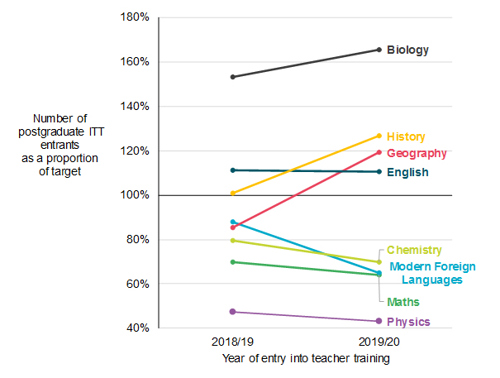UK General Election 2019: why tackling the teacher supply challenge needs to be a top priority for the next Government
Thursday 28 November 2019

A version of this post first appeared in Schools Week.
Today’s Department of Education (DfE) teacher training statistics show the number of secondary trainee teachers falling below target for the seventh year running. It is clear that tackling the teacher supply challenge will need to be a top priority for the next Government. Here we look at what the three main political parties are proposing to address the challenge.
Despite the number of secondary trainees increasing again this year compared to last year, the latest teacher training data shows that the numbers are not sufficient to meet the recruitment target, which has also increased. Training enough teachers to meet the rapidly growing demand for secondary teachers, in response to increasing pupil numbers, continues to be a pressing challenge for the English education system.
The recruitment picture varies enormously between different subjects, and this year’s data highlights a notable divergence in fortunes (see chart). The recruitment situation has deteriorated further for perennial shortage subjects such as physics, maths, modern foreign languages and chemistry. In contrast, subjects that have had less difficulty recruiting in recent years, including biology and history, are generally overshooting their targets by more than last year.

History recruitment has exceeded its target again this year after more than five years of successful recruitment, increasing to 27 per cent over target compared to one per cent last year. English is 10 per cent above target, down slightly from 11 per cent last year.
However, subjects with long-term recruitment issues continue to fall below their respective targets for maintaining supply. Recruitment to teacher training in Maths is 36 per cent below target, compared to 30 per cent last year and 23 per cent the year before. Recruitment to train in Modern Foreign Languages (MFL) also continues to be below the target, this year by 35 per cent compared to 12 per cent last year.
The science subjects are an area of particular concern, but also extreme contrast. Recruitment to biology training this year was 66 per cent above target, up from 53 per cent over target last year. In contrast, physics has slumped to 57 per cent below target (compared to 50 per cent below last year) and chemistry is 30 per cent below target (compared to 20 per cent last year).
As we blogged last year, to say that the recruitment for all science teachers is 92 per cent of target this year, as it was 94 per cent last year, assumes that biology teachers are perfectly interchangeable with physics teachers. These diverging trends put the spotlight on how well-equipped biology trainees are to teach physics and chemistry, and how they might best be supported to do so as the need increases.
What are the political parties planning to do to address the teacher supply challenge?
Today’s teacher training statistics reinforce the need for the next government to continue to treat secondary school teacher supply as a top priority. Effective measures to increase the number of trainees are essential to meet growing demand and increasing the retention of existing teachers would help to ease supply issues and make future recruitment targets easier to achieve. We look at what the manifestos of the three main political parties are offering on teacher recruitment and retention.
Recruitment
Increases in teachers’ pay feature strongly in each party’s proposals. After years of below-inflation pay rises up until 2018/19, increases in school spending and teacher pay are back on the political agenda. Both the Conservative and Liberal Democrat manifestos commit to increasing teachers’ starting salaries to £30,000 by 2022/23. Labour proposes five per cent year-on-year increases in pay across the public sector (including teachers), which would also bring teachers’ starting salaries to around £30,000 by the same time.
There is good evidence that teacher recruitment is fairly responsive to pay relative to what is on offer in other professions, among other economic factors such as job security in the wider labour market (which is currently quite high). These plans therefore seem likely to increase recruitment to teacher training.
Retention
While there is a consensus among the parties that teachers’ pay needs to increase significantly, especially for new teachers, there is less consensus in the parties’ plans over how best to retain more teachers. Increasing teacher pay is also likely to have some positive effect on retention. However, the research evidence (which we reviewed in a new report for the Royal Society published yesterday) suggests that the relationship between relative pay and retention is less strong than with recruitment.
The evidence also suggests that pay increases designed to improve teacher retention are likely to be best value for money when they are targeted at groups of teachers who are most responsive to pay differentials, such as early-career teachers and teachers of subjects with well-paid alternatives outside of teaching. The parties’ offers of teacher pay rises that are not differentiated by subject do not directly help to address the higher leaving rates among teachers in shortage subjects.
Workload
A key pillar of the DfE’s teacher recruitment and retention strategy was to improve retention by supporting headteachers to reduce teachers’ unnecessary workload. The government policy has been to ‘simplify the system’ of accountability and school intervention and to ‘provide additional support to tackle challenging pupil behaviour’. It also committed to maintain a period of stability in curriculum, qualifications and assessment. The Conservative manifesto suggests that this stability is likely to continue, with only a renewed commitment to ‘improving behaviour’.
In contrast, the Labour and Liberal Democrat manifestos propose radical reform to the accountability system, with a key aim to improve teacher retention. Labour declares that ‘intensified testing, inspection, league tables and competition… are contributing to a growing teacher recruitment and retention crisis’ and proposes to ‘end the ‘high stakes’ testing culture of schools’ and ‘replace Ofsted and transfer responsibility for inspections to a new body’.
Similarly, the Liberal Democrats are proposing to ‘replace Ofsted with a new HM Inspector of Schools’ that focuses on, among other things, ‘the wellbeing of staff’ and ‘reduce unnecessary stress on pupils and teachers … by scrapping SATs’.
It remains to be seen what the overall impact of substantial changes to the accountability system would mean for teacher workload and retention.
Subject-specific teacher recruitment and retention?
Today’s teacher training statistics highlight the need for policy proposals that differentiate by subject to address the particular recruitment and retention challenges those subjects face. None of the party manifestos set out any plans for targeted approaches for addressing the under-recruitment and high leaving rates of shortage-subject teachers.
Whichever party takes office next month, they will have to include measures to address this issue within their overall strategy, to ensure that the secondary school system has the right number of teachers in each subject to deliver a high-quality education for pupils.
Over the next few weeks, we will continue to monitor what the main parties offer voters on education and produce evidence-based blogs on topics high on the agenda. Keep up-to-date on our election activities on our Twitter or by signing up to receive blog notifications direct to your inbox here.
